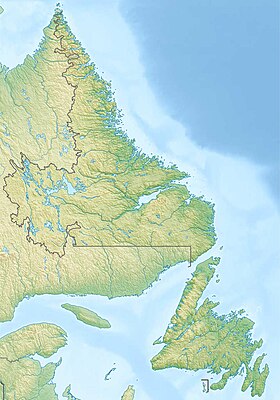NunatuKavummiut
| Total population | |
|---|---|
| ~6,000[1] | |
| Regions with significant populations | |
| Central and southern Labrador (Canada) | |
| Languages | |
| Newfoundland English | |
| Religion | |
| Christianity (Protestantism, Evangelicalism), Animism | |
| Related ethnic groups | |
| Inuit, European Canadians |
| Person | NunatuKavummiuk |
|---|---|
| People | NunatuKavummiut |
| Language | Inuttut; Uukturausingit |
NunatuKavummiut, also called the "people of NunatuKavut", are a group of people living in central to southern Labrador who self-identify as being of mixed Inuit and European heritage.
While some members of NunatuKavut communities have used the term Métis, they are unrelated to the Métis of Western Canada.
Nunatuĸavut or NunatuKavut means "Our ancient land" in the traditional Inuttitut dialect of central and southern Labrador. The region claimed by the NunatuKavut Community Council encompasses southern Labrador, from the Grand River (Newfoundland name: Churchill River), south to Lodge Bay and west to the extent of the official border between Quebec and Labrador. However, their proposed land use area is much more extensive.[2]
The NunatuKavut Community Council and its approximately 6,000 members have not been recognized by other Indigenous groups and organizations, such as the Nunatsiavut Government, the Innu Nation, Inuit Tapiriit Kanatami, and the Inuit Circumpolar Council.[3][4][5][6]
History
[edit]Arrival in southern Labrador
[edit]NunatuKavummiut claim to be the descendants of Inuit who occupied and used the southern shore of Lake Melville and the coastal regions of Labrador south of Groswater Bay for thousands of years, long before the Government of Newfoundland and Labrador made any real foray into the area in the early 20th century.[7]
According to widely accepted theory, Inuit arrived in Labrador in the 15th century from Baffin Island[citation needed]. Archeological evidence shows they lived as far south as the Sandwich Bay area,[8] and other archeological and anthropological evidence suggests with some certainty that they lived year round as far south as the modern day southern border between Labrador and Quebec, though occupation was likely much more extensive and consistent than that as most NunatuKavummiut lived a transhumant semi-nomadic way of life until the mid-1900s.[9]
Contact with Europeans
[edit]Inuit were in conflict with the Basque and French whalers beginning in the mid-1500s.
Marriage between Europeans and Inuit
[edit]During the 19th century, some European men, settled, took Inuit wives, and permanently assimilated into the local culture. Although influenced in many ways by prolonged contact with seasonal workers and merchants, the culture and way of life has remained distinctly Inuit.[10]
Distribution
[edit]The traditional territory of NunatuKavummiut consists of a region of southern shore of Lake Melville and southern Labrador that encompasses communities from Mud Lake in southeast Lake Melville to the modern border of Labrador and Quebec.[11]
While recent leadership of Nunatsiavut and Inuit Tapiriit Kanatami continue to make claims against the indigeneity of NunatuKavummiut based on the intermixing of European men,[12] many Inuit in the southern parts of Nunatsiavut are also descended from fur traders that worked in the region in the last couple of hundred years.
Like all Indigenous Nations in Newfoundland and Labrador, including Nunatsiavut, Innu Nation, and the Conne River Mi'kmaq, NunatuKavut also has a large diaspora in many other parts of Newfoundland and Labrador and across the world.[citation needed]
Organization
[edit]NunatuKavummiut are today represented by the NunatuKavut Community Council which was formed in 2010 from its predecessor the Labrador Métis Nation (formerly Labrador Métis Association).[13] They are members of the Congress of Aboriginal Peoples along with other non-Status Aboriginal groups.[14]
Land claim
[edit]NunatuKavummiut claim NunatuKavut as their homeland, and are in process of launching an Aboriginal land claim with the Canadian courts. They are also active in the debates over the Lower Churchill hydroelectric project, and the dam at Muskrat Falls.[15]
Notable NunatuKavummiut
[edit]- Lisa Dempster, politician
- Jennifer Hale, voice actress
- Yvonne Jones (born 1968), politician
- Todd Russell (born 1966), politician, president of NunatuKavut
See also
[edit]- List of organizations that self-identify as Native American tribes
- Nunavik
- Nunavut
- Labrador Inuit Pidgin French
Further reading
[edit]- Canadian Government: NunatuKavut Land Claim Document
- NunatuKavut Community Council Inc.
- Labrador Inuit History
- Canadian Encyclopedia; Inuit presence in southern Labrador
- Royal Commission White Paper on Renewing and Strengthening Our Place in Canada
References
[edit]- ^ "Who We Are". Nunatukavut.ca. Retrieved October 23, 2024.
- ^ The forgotten Labrador (Cleophas Belvin; ISBN 0-7735-3151-3; (bound))
- ^ "Inuit leader warns of Labrador group's 'illegitimate claims' to Inuit identity". CBC. May 12, 2023. Retrieved September 23, 2024.
- ^ "Court dismisses Innu Nation challenge against recognition of disputed Labrador group". CBC. March 19, 2024. Retrieved September 23, 2024.
- ^ Rogers, Sarah (March 19, 2024). "Inuit and Innu United Against False Claims of Indigenous Identity". Inuit Tapiriit Kanatami. Retrieved September 23, 2024.
- ^ "Statement on the Nunatukavut Community Council (NCC)". Inuit Circumpolar Council. November 10, 2023. Retrieved October 23, 2024.
- ^ The Story of Labrador by Bill Rompkey Publisher: Montreal : McGill-Queen's University Press, 2003. ISBN 0-7735-2574-2 DDC: 971.82 LCC: FC2149.4 Edition: (bound)
- ^ "Southern Inuit of NunatuKavut: The Historical Background". www.heritage.nf.ca. Retrieved 2022-09-10.
- ^ "Attributing Cultural Affiliation to Sod Structures in Labrador: A Labrador Métis Example from North River". Retrieved 29 April 2024.
- ^ "Royal Commission White Paper on Renewing and Strengthening Our Place in Canada". www.exec.gov.nl.ca. Retrieved 2022-09-10.
- ^ "Attributing Cultural Affiliation to Sod Structures in Labrador: A Labrador Métis Example from North River". Retrieved 29 April 2024.
- ^ "English – An Open Letter from ITK to Alert Canadians to False Claims to Inuit Identity". Retrieved 29 April 2024.
- ^ "Labrador's Métis Nation adopts new name | CBC News". CBC News. 2010-04-13. Retrieved 2022-09-10.
- ^ "Affiliates". www.abo-peoples.org. Archived from the original on 2012-11-05. Retrieved 2012-11-29.
- ^ "NunatuKavut says it's not backing away from the Lower Churchill development". the Telegram. Archived from the original on 2012-10-06. Retrieved 2012-09-19.

